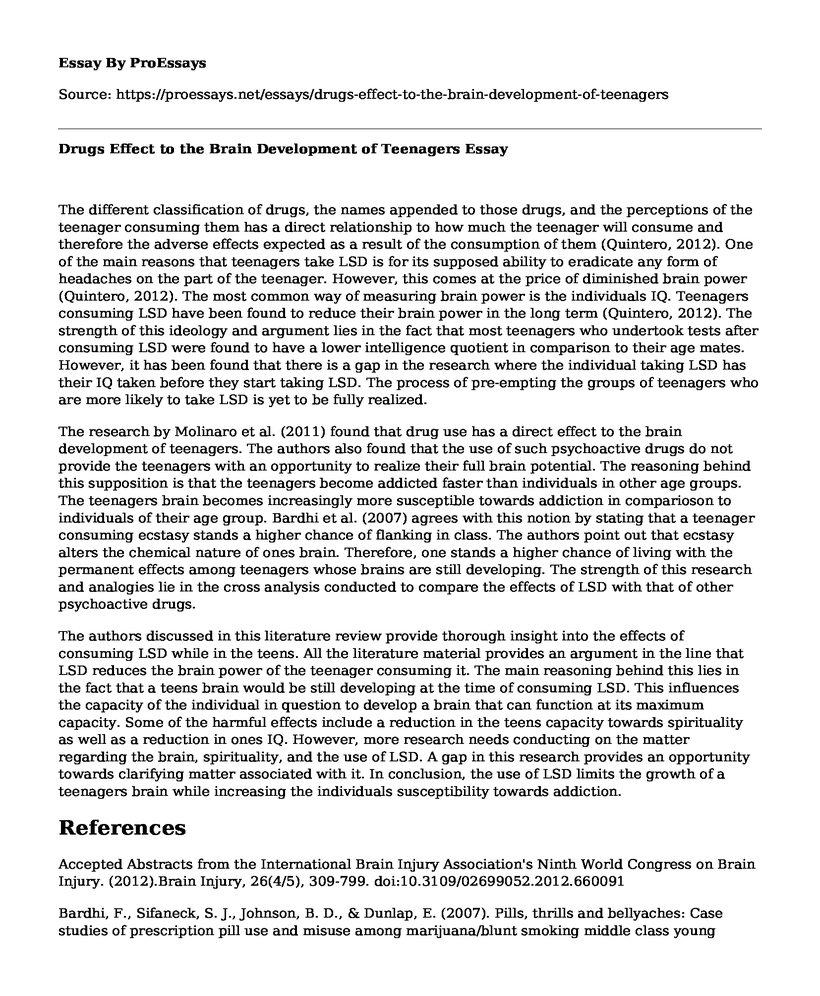The different classification of drugs, the names appended to those drugs, and the perceptions of the teenager consuming them has a direct relationship to how much the teenager will consume and therefore the adverse effects expected as a result of the consumption of them (Quintero, 2012). One of the main reasons that teenagers take LSD is for its supposed ability to eradicate any form of headaches on the part of the teenager. However, this comes at the price of diminished brain power (Quintero, 2012). The most common way of measuring brain power is the individuals IQ. Teenagers consuming LSD have been found to reduce their brain power in the long term (Quintero, 2012). The strength of this ideology and argument lies in the fact that most teenagers who undertook tests after consuming LSD were found to have a lower intelligence quotient in comparison to their age mates. However, it has been found that there is a gap in the research where the individual taking LSD has their IQ taken before they start taking LSD. The process of pre-empting the groups of teenagers who are more likely to take LSD is yet to be fully realized.
The research by Molinaro et al. (2011) found that drug use has a direct effect to the brain development of teenagers. The authors also found that the use of such psychoactive drugs do not provide the teenagers with an opportunity to realize their full brain potential. The reasoning behind this supposition is that the teenagers become addicted faster than individuals in other age groups. The teenagers brain becomes increasingly more susceptible towards addiction in comparioson to individuals of their age group. Bardhi et al. (2007) agrees with this notion by stating that a teenager consuming ecstasy stands a higher chance of flanking in class. The authors point out that ecstasy alters the chemical nature of ones brain. Therefore, one stands a higher chance of living with the permanent effects among teenagers whose brains are still developing. The strength of this research and analogies lie in the cross analysis conducted to compare the effects of LSD with that of other psychoactive drugs.
The authors discussed in this literature review provide thorough insight into the effects of consuming LSD while in the teens. All the literature material provides an argument in the line that LSD reduces the brain power of the teenager consuming it. The main reasoning behind this lies in the fact that a teens brain would be still developing at the time of consuming LSD. This influences the capacity of the individual in question to develop a brain that can function at its maximum capacity. Some of the harmful effects include a reduction in the teens capacity towards spirituality as well as a reduction in ones IQ. However, more research needs conducting on the matter regarding the brain, spirituality, and the use of LSD. A gap in this research provides an opportunity towards clarifying matter associated with it. In conclusion, the use of LSD limits the growth of a teenagers brain while increasing the individuals susceptibility towards addiction.
References
Accepted Abstracts from the International Brain Injury Association's Ninth World Congress on Brain Injury. (2012).Brain Injury, 26(4/5), 309-799. doi:10.3109/02699052.2012.660091
Bardhi, F., Sifaneck, S. J., Johnson, B. D., & Dunlap, E. (2007). Pills, thrills and bellyaches: Case studies of prescription pill use and misuse among marijuana/blunt smoking middle class young women. Contemporary Drug Problems, 34(1), 53-101.
Chakraborty, K., Neogi, R., & Basu, D. (2011). Club drugs: review of the 'rave' with a note of concern for the Indian scenario. Indian Journal Of Medical Research, 133(6), 594-604.
Joe-Laidler, K., & Hunt, G. (2013). Unlocking the Spiritual With Club Drugs: A Case Study of Two Youth Cultures.Substance Use & Misuse, 48(12), 1099-1108. doi:10.3109/10826084.2013.808067
Molinaro, S., Siciliano, V., Curzio, O., Denoth, F., Salvadori, S., & Mariani, F. (2011). Illegal Substance Use among Italian High School Students: Trends over 11 Years (1999-2009). Plos ONE, 6(6), 1-9. doi:10.1371/journal.pone.0020482
Pandey, G. N. (2013). Biological basis of suicide and suicidal behavior. Bipolar Disorders, 15(5), 524-541. doi:10.1111/bdi.12089
Quintero, G. (2012). Problematizing "drugs": A cultural assessment of recreational pharmaceutical use among young adults in the United States. Contemporary Drug Problems, 39(3), 493-535.
Cite this page
Drugs Effect to the Brain Development of Teenagers. (2021, Mar 12). Retrieved from https://proessays.net/essays/drugs-effect-to-the-brain-development-of-teenagers
If you are the original author of this essay and no longer wish to have it published on the ProEssays website, please click below to request its removal:
- Research Paper on Foster/Adoptive Parents
- How ADD Affects People's Ability to Write? Essay Example
- Paper Example on Sierra Club: A Non-Profit Environmental Organization in America
- Essay Example on Segregation in Schools: Children Fight for Equality and Liberty
- Essay Example on the Benefits of Being a Vegetarian: Supporting a Greener Environment
- Essay Example on Effective Comm: Tool to Maximize Worker Info Dissemination
- Single Parent Struggles: Assessing Problem-Solving Approaches - Essay Sample







